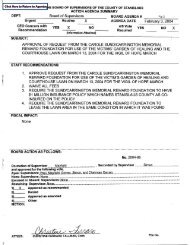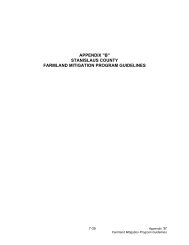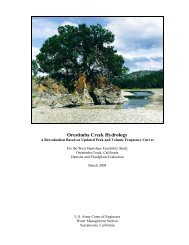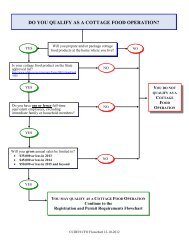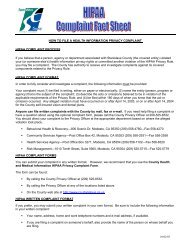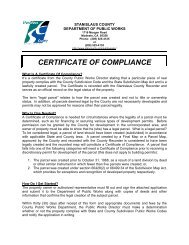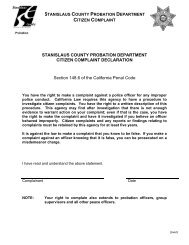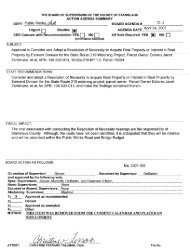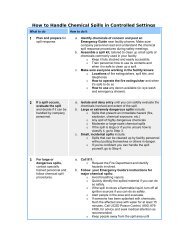Orestimba Creek Feasibility Study - Stanislaus County
Orestimba Creek Feasibility Study - Stanislaus County
Orestimba Creek Feasibility Study - Stanislaus County
Create successful ePaper yourself
Turn your PDF publications into a flip-book with our unique Google optimized e-Paper software.
Economics Appendix – Draft Report - <strong>Orestimba</strong> <strong>Creek</strong> <strong>Feasibility</strong> <strong>Study</strong>, <strong>Stanislaus</strong> <strong>County</strong>, California – September 2012<br />
Special Consideration for Specialty, Truck Crops, and Selected Field Crops<br />
Vegetable crops raised for direct human consumption are vulnerable to passing on the E.Coli<br />
bacteria to humans through contamination from animals. In 2006 an E. coli outbreak traced to<br />
bagged spinach was blamed for the deaths of three people and for sickening hundreds more<br />
across the U.S. Authorities ultimately identified a central California cattle ranch next to a<br />
spinach field as being the source of the bacteria. In 2007 salad mix packaged by a major food<br />
processor tested positive for E.coli and triggered a recall in at least nine states. The ultimate cost<br />
to the processor and the producers are unknown but is determined to be of significant proportions<br />
and is deemed to be life threatening.<br />
Between 1999 and 2006, there were 12 outbreaks of E. Coli traced to California leafy greens<br />
resulting in 539 reported illnesses. Of those 12 outbreaks, 10 were on fresh-cut leafy greens and<br />
those 10 outbreaks involved 531 of the illnesses. In addition to E. Coli, a recent announcement<br />
from the Centers for Disease Control and Prevention on June 11 of 2008 confirms that a<br />
salmonella outbreak has struck at least 167 people in 17 states. The Food and Drug<br />
Administration estimates that an average of 2 to 4 million cases of salmonellosis occur annually<br />
in the U.S. This particular outbreak (in 2008) was linked to raw tomatoes infected by<br />
microscopic bacteria that live in the intestinal tracks of people and animals. The infection is<br />
spread by the ingestion of raw or undercooked food and water that is contaminated with feces<br />
carrying the bacteria. Contaminated goods usually stem from animal origin but are not limited to<br />
and often include vegetation and water. In the 2008 incident, restaurants and supermarkets<br />
stopped selling tomatoes altogether or only carried tomatoes deemed safe by the FDA.<br />
Even slight flooding of fields has the associated probability of carrying animal waste in the<br />
floodwater, and accordingly, may carry the E.coli and salmonella bacteria. In an article titled<br />
Transmission of Escherichia coli 0157:H7 from Contaminated Manure and Irrigation Water to<br />
Lettuce Plant tissue and Its Subsequent Internalization, 10 the authors stated:<br />
“ Application of E.coli 0517:H7-contaiminated manure to the production field or<br />
irrigation with E.coli 0157:H7-contaminated water may result in contamination of<br />
the crop in the field. Studies have indicated the E.coli can survive for extended<br />
periods in manure and water. We have demonstrated that lettuce grown in soil<br />
containing contaminated manure, or irrigated with contaminated water, results in<br />
contamination of the edible portion of the lettuce plant. Moreover, the results suggest<br />
that edible portions of a plant can become contaminated without direct exposure to a<br />
pathogen, but rather through transport of the pathogen into the plant by the root<br />
system.”<br />
The National Organic Producer regulation provides guidelines on the use of manure that is<br />
applied to croplands. There are guidelines associated with the management practices of using<br />
manure, which consider both the state of the manure and the intended use of the product to which<br />
the manure is being applied.<br />
10 Subject article written by Ethan B. Solomon, Sima Yaron, and Karl R. Matthews, Department of Food Science,<br />
Rutgers University, New Brunswick, New Jersey, appeared in “Applied and Environmental Microbiology,” January<br />
2002, p. 397-400, Vol 68, No. 108901.<br />
59




